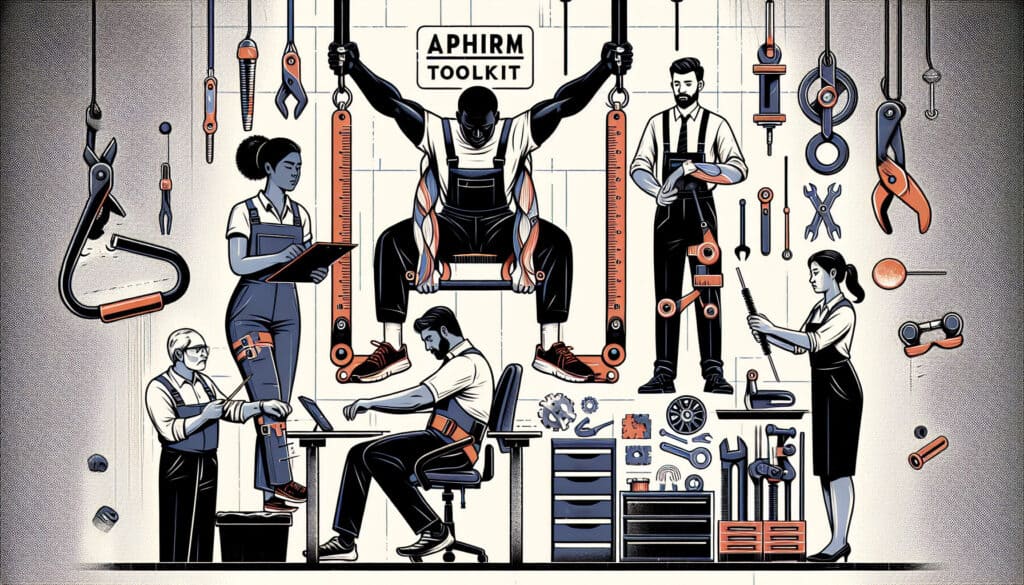A toolkit of resources developed in Australia to help organizations manage the risks of musculoskeletal disorders.
- Méthodologies : Ergonomie, Ressources humaines, Gestion des risques
APHIRM Toolkit

APHIRM Toolkit
- Amélioration continue, Ergonomie, Sciences de la santé, Facteurs humains, Amélioration des processus, Gestion de la qualité, Gestion des risques, Safety, Pratiques de durabilité
Objectif :
Comment il est utilisé :
- The APHIRM (A Participative Hazard Identification and Risk Management) toolkit provides a step-by-step guide to identifying, assessing, and controlling musculoskeletal hazards in the workplace. It includes a range of practical tools, such as checklists and worksheets.
Avantages
- Provides a practical and easy-to-use framework for managing musculoskeletal risks, is based on a participative approach, and has been developed specifically for Australian workplaces.
Inconvénients
- May not be applicable to all countries or industries, requires a commitment from management and workers to be effective, and may not be suitable for all types of musculoskeletal hazards.
Catégories :
- Ergonomie, Ressources humaines, Gestion des risques
Idéal pour :
- Managing the risks of musculoskeletal disorders in Australian workplaces.
The APHIRM Toolkit is particularly valuable in industries such as healthcare, manufacturing, and logistics, where manual handling and repetitive tasks are prevalent. It is applicable throughout various project phases, including initial design, implementation, and ongoing maintenance. A multidisciplinary team, including health and safety officers, ergonomic specialists, and front-line workers, typically initiates the risk assessment process, ensuring that insights and experiences from those directly affected inform the evaluation of hazards. The participative nature of the toolkit allows for input from a diverse range of stakeholders, making it adaptable to different workplace environments and practices. The practical tools, such as checklists and worksheets, promote engagement and facilitate straightforward applications, regardless of the existing level of expertise in risk management. Regularly integrating the APHIRM methodology into workplace safety programs not only promotes compliance with Australian Safe Work regulations but also encourages a culture of safety that aims to reduce the incidence of musculoskeletal disorders. By ensuring that risk management is a shared responsibility, workplaces can foster ongoing dialogues about safety measures, leading to continuous improvement in ergonomic practices and better health outcomes for employees. Through its integrated approach, the toolkit also serves as a blueprint for conducting training sessions and workshops focused on risk identification and mitigation strategies, empowering teams to proactively address issues related to musculoskeletal health.
Principales étapes de cette méthodologie
- Identify musculoskeletal hazards through workplace evaluations and observations.
- Assess the level of risk associated with identified hazards using qualitative or quantitative measures.
- Engage stakeholders in developing control strategies to mitigate identified risks.
- Implement the chosen control measures and ensure that all staff are informed.
- Monitor the effectiveness of the implemented controls and gather feedback from employees.
- Review and update the risk management process regularly to reflect changes in the workplace or emerging risks.
Conseils de pro
- Incorporate ergonomic assessments into regular workflow evaluations to identify subtle hazards that may not be immediately visible.
- Utilize feedback loops from participating employees to continuously refine and improve risk management strategies based on real experiences.
- Leverage data analytics tools to monitor trends in musculoskeletal disorders and adapt interventions proactively based on identified patterns.
Lire et comparer plusieurs méthodologies, nous recommandons le
> Référentiel méthodologique étendu <
ainsi que plus de 400 autres méthodologies.
Vos commentaires sur cette méthodologie ou des informations supplémentaires sont les bienvenus sur le site web de la Commission européenne. section des commentaires ci-dessous ↓ , ainsi que toute idée ou lien en rapport avec l'ingénierie.
Contexte historique
1986
(si la date est inconnue ou n'est pas pertinente, par exemple "mécanique des fluides", une estimation arrondie de son émergence notable est fournie)

Articles Similaires
Questionnaires sur les troubles musculo-squelettiques
Tests à plusieurs variables (MVT)
Analyse de régression multiple
Systèmes de capture de mouvement
Méthode MoSCoW
Test de la médiane de Mood